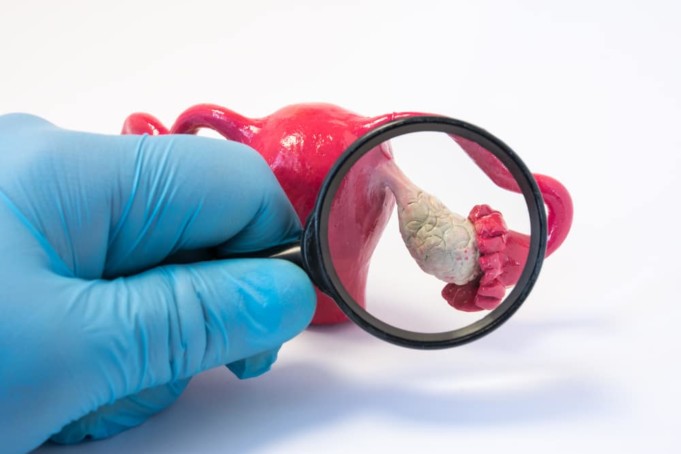Ovarian Cyst is one of the most rarely type of diagnosed disease in women but it’s one of the leading causes of infertility in women if left unchecked. Some of the ovarian cysts are absolutely not harmful and perfectly normal while some may grow and develop into ovarian cancers.
Then what exactly is a cyst? You may be wondering. Well, let’s get started, shall we? A cyst is a sac or a small pouch that contains fluid in it. This forms when there is an accumulated concentration of fluid within the ovary.
It is mostly surrounded by a shell and most times they vary in sizes depending on how large or how small it is. In some women, it is very small and may almost be looking like a pouch while in other women, it is so big that one would think that they are pregnant.
It mostly occurs while the woman is within her fertility or reproductive years (I.e. within the years in which she can give birth and likewise go on her ovulation and menstrual cycle). Most times, ovarian cysts can cause severe pain and bleeding. Sometimes, it mostly can be an indicator of ovarian cancer.
Most times, the body simply sets and puts up to get ovarian cysts. In most cases, as a woman is on her menstrual cycle, there is a 99% chance that you may develop a harmless ovarian cyst which would sometimes go away on its own.
During a woman’s menstrual cycle, it is normal for the ovarian or graffian follicle to release matured eggs but then again, sometimes, they don’t release these eggs and these eggs have the tendency to grow bigger and larger, developing into a follicular cyst.
Sometimes, rather than developing into a follicular cyst, it will develop into something else called a CORPUS LUTEUM CYST. This cyst develops after the graffian follicle has released the egg and then it has developed a CORPUS LUTEUM.
Mostly these cysts are usually a few millimetres in length and this type usually resolves on its own but sometimes, it can be very large. They may sometimes cause severe pain by twisting and turning the ovary, but they are usually not cancerous.
Another type of cyst sometimes develops after the matured eggs have begun dividing even without fertilization taking place and this type of cyst is called a DERMOID CYST also known as Mature cystic Teratoma.
They are very rare and uncommon, but they can still develop. DERMOID CYSTS mostly already contain genetic information and materials for human life, they sometimes contain hair follicles, nail particles, and even sometimes teeth are usually found in it. It usually occurs in teenage girls and young ladies.
There are some ovarian cysts that occur not during the menstrual cycle but after the menstrual cycle and these cysts are known as OVARIAN TUMORS.
Some of these tumours may have fluid filled in it just like the ovarian cysts while others can have solid components filled in it. Likewise, there are some other tumours which have both solid and fluid components in it.
There is a difference between ovarian cysts and ovarian tumours and it is the fact that while ovarian cysts can probably resolve itself in its own, ovarian tumours will need to be removed through a surgical operation.
 There are some other ovarian cysts that though are very rare and uncommon in women, they still occur or show up in a minor number of women. Even though they are rare, one should still have the knowledge of them hence their addition in this article. They include:
There are some other ovarian cysts that though are very rare and uncommon in women, they still occur or show up in a minor number of women. Even though they are rare, one should still have the knowledge of them hence their addition in this article. They include:
- Mucinous Cystadenoma: In this kind of ovarian cyst, instead of it having a fluid like content, it has mucous filled in it. It is usually the most commonly seen among the rare types. It almost always starts out benign but with time, it can grow very large
- Serous Cystadenoma: Mostly seen in this kind of ovarian tumour is a serious clear yellow fluid.
- Endometrioma: This kind of Ovarian Cysts contains mostly fluid found in the endometrium (inner layer) of the uterus. These cysts usually occur in women who already have an underlying problem; mostly endometriosis. These kinds are usually severely painful during sex but most especially painful during a woman’s menstrual period.
Due to the kind of the nature and colour of the fluid that is found in this kind of cyst, it was given the nickname “Chocolate Cysts”
Polycystic ovarian syndrome: This is a special kind of ovarian cyst. This kind of syndrome causes the development and growth of several small multiple ovarian cysts that are benign on the ovary. Most of the time, it is present due hormonal imbalance.
Symptoms of these syndrome includes irregular menstrual cycle and elevated levels of testosterone in the woman thereby causing the excess development of the male features such as broad shoulders, deep voice, excessive hair development on the chest etc.
In most cases, these multiple cysts disappear on their own without causing any difficulties or problems. What then are the signs and symptoms that should be observed by one with ovarian cysts?
Most ovarian cysts usually relapse and take care of themselves without causing any symptoms. However, some don’t go like that and the most likely symptoms presented includes;
- Pain during sex with one’s partner
- Bleeding: Unusual and heavy bleeding is usually associated with these cysts
- Vomiting too might occur
- Abdominal heaviness and fullness
- Twisting and turning of the cysts around the blood supply of the uterus causing severe sometimes unbearable pains. This twisting and turning is called TORSION.
- Low back Pain
- Indigestion
- Frequent urination because the cysts have become so large that it starts to press against the bladder.
- Frequent defecation
- Severe pains while having bowel movements.
Sometimes, these cysts could get so large such that it can rupture and burst. If the cyst was still small before it ruptured, it might not cause severe symptoms but if it had become large before bursting, it can lead to severe pain and internal bleeding.
It might even cause sepsis. The pain usually comes on suddenly with an early onset and occurs on one side of the abdomen only. The pain can begin to occur during or after a very strenuous exercise. It may also likewise rupture during sex.
Most of these ovarian cysts usually go by themselves. They disappear usually within 3 months without causing rupture. But some do rupture causing pain but usually they are beginning, and they don’t cause any problems medically.
The treatment of ovarian cysts depends greatly on the cause and also the stage at which the ovarian cyst was found. Other determinant factors are the age of the woman, her size, the appearance and position of the cyst, will determine the kind treatment to be administered.
But mostly, if the cyst doesn’t rupture or take care of itself, then a surgical operation is needed. Most tumours that are malignant and some which are even benign are surgically removed.
Although for managing the pain, mostly non-steroidal anti-inflammatory drugs are administered. It should be noted however that no home remedies or natural herbs can treat ovarian cysts.












